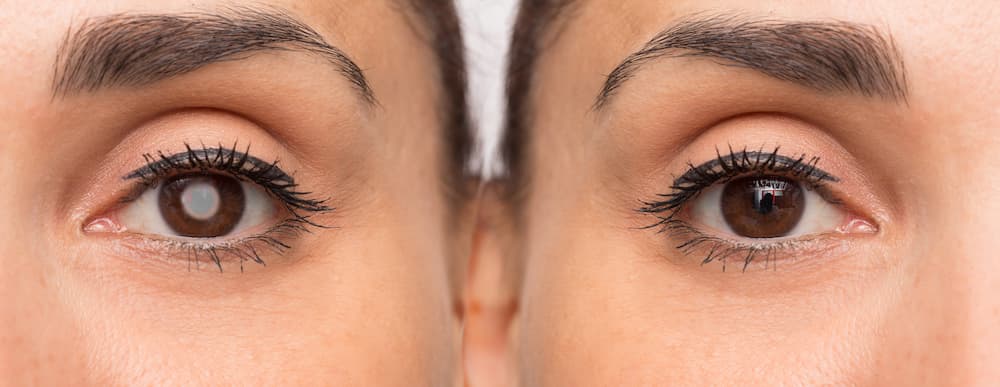
Cataract surgery is a quick, effective, and painless eye surgery that targets vision problems caused by cataracts. For 90% of individuals that undergo cataract surgery, the procedure is successful – and they experience measurable improvements in their vision.
Our guide can help you make a confident and informed decision if you are considering cataract surgery.
What is Cataract Surgery?
Cataract surgery is a specialized surgical procedure that removes a cataract or cloudy lens. The procedure is performed by an ophthalmologist, a type of eye doctor.
The lens in your eye is essential for focusing light and usually is clear. However, when the lens becomes cloudy, it obscures your vision and is referred to as a “cataract.” A cataract can cause blurry, cloudy, or dim vision, affecting how you see colors, creating light sensitivity, or making it difficult to see at night. It is common for cataracts to develop around the age of 40, as the proteins in the eye’s lens naturally break down. However, vision changes are not typically noticeable until age 60, but this can vary.
The cloudy lens is removed and replaced during cataract surgery by an intraocular lens (IOL). This clear artificial lens restores your vision.
Types of Cataract Surgery
There are three primary cataract surgery types:
- A small incision (phacoemulsification): The surgeon will create a small opening in the cornea (the transparent cover over your eye), using a specialized tool to send sound waves to break up the cataract into small pieces. Then, a tiny vacuum is used to collect the cloudy lens pieces. The new, artificial lens is then inserted. The incision is so tiny that no stitches are necessary.
- Extracapsular: In this approach, a slightly larger incision is made to attempt to remove the cataract in one piece. This cataract surgery is often utilized when a cataract is mainly cloudy because it can be challenging to break up these cataracts with phacoemulsification.
- Laser-assisted surgery: Rather than using a small scalpel, your doctor might choose to use a laser for your surgery. The laser is used to make the incision on the cornea and soften the cataract to make it easier to remove. Depending on your situation, your doctor may also be able to use the laser to treat specific vision problems during the procedure.
Types of Intraocular Lenses (IOLs)
Your doctor will also help you choose the best intraocular lens (IOL) for your needs. The IOL is the artificial lens used to replace the old, clouded lens. IOLs are made with different focusing powers, some of which may eliminate your need for glasses after surgery.
Available types of IOLs include:
- Monofocal IOLs: Intended for close, medium, or long-range distance vision. Many patients opt to have them set for distance vision and then use reading glasses for close-up vision.
- Multifocal IOLs: Allow for near and far focus at the same time.
- Accommodative IOLs: Allow for effective focusing at various distances.
- Toric IOLs: Correct the refractive error that causes astigmatism.
Do I Need Cataract Surgery?
The easiest way to determine if you need cataract surgery is to ask yourself if your vision problems affect your day-to-day life. For example, are you able to work and drive safely? Can you still enjoy your hobbies, such as reading or watching TV?
It is important to understand that, without treatment, cataracts can continue to worsen. As cataracts increase, they can cause vision loss and even blindness.
Your doctor can help you decide if it is the right time for cataract surgery.
What are the Benefits of Cataract Surgery?
The clearest advantage of cataract surgery is that it is the only available procedure to get rid of a cataract and restore your vision. It has an excellent success rate when it comes to improving patients’ vision.
After cataract surgery, you can expect to experience benefits such as:
- Clearer vision
- Less glare when looking at bright lights
- Increased ability to tell the difference between various colors
What are the Risks of Cataract Surgery?
Cataract surgery is a routine procedure that is widely considered highly safe. However, like any surgery, there are certain risks, such as:
- Eye infection
- Retinal detachment
- Blurred vision
- Visual disturbances (halos, shadows, or glare)
Your doctor can walk you through the potential risks of cataract surgery to help put you at ease.
Before Cataract Surgery
The first step in preparing for cataract surgery will be an eye examination to assess the size and location of the cataract. You and your doctor will discuss your present health, any medications you currently take, and your goals.
In addition, your doctor will measure your eye to determine which type of intraocular lens (IOL) is ideal for you.
Before the procedure, you may also need to stop taking certain medications. You may also be provided with antibiotic eye drops to reduce the risk of infection after surgery.
Keep in mind that, although cataract surgery is an outpatient procedure, you will need someone available to drive you home afterward.
During Cataract Surgery
You can expect a fairly short and simple procedure on the day of your cataract surgery. First, your doctor will administer a numbing medication to the eye that will be treated. You may also receive medication to serve as a relaxation aid.
Although you will be awake during the procedure, you will not be able to feel anything. You may see the light and movement, but you will not see the actual procedure inside your eye.
Once the preparations are complete, your doctor will utilize a specialized microscope to get a clear, up-close view of your eye. They will remove the cataract, replacing it with a new lens.
The last step is placing a shield (similar to an eye patch) to protect your eye and allow proper healing.
How long does cataract surgery last?
The entire procedure only takes between 20 and 30 minutes, with the actual cataract removal requiring just a few minutes.
After Cataract Surgery
Recovery from cataract surgery is a reasonably simple, straightforward process. Typically, you can go home within 30 minutes or so after surgery.
You may be permitted to remove the eye shield the next day, although it may be recommended that you wear it while sleeping.
For about four weeks, you will use special eye drops to aid in your recovery.
You can expect follow-up appointments with your doctor to check the healing process and assess the final outcome.
Get More Details about Cataract Surgery in Shreveport from the WK Eye Institute
Are you concerned that you may need cataract surgery? Our team of professionals at the WK Eye Institute can help you determine your best next steps. If you are a good candidate for surgery, our Shreveport cataract surgery experts can help you prepare to achieve the best possible outcome.
Your first step towards improving vision problems is a consultation with one of our skilled and dedicated doctors. Contact us to schedule your appointment at our cataract surgery center today.
Image Source: sruilk / Shutterstock



